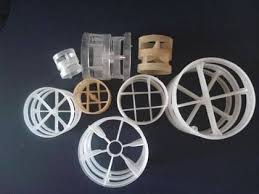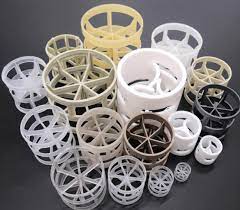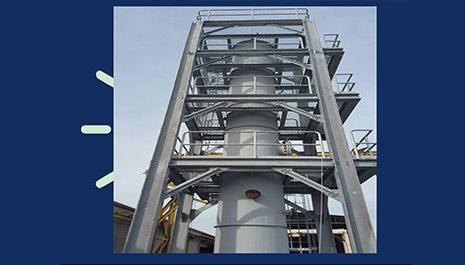Pall rings are the most commonly used form of random packaging. They are made of metal and plastic. They also have different applications. Our experts will provide you with the most beneficial information about Pall Rings through this article. To learn more, read on.
What is a Pall Ring?
Pall Ring is a random ring type packaging. They attempt to increase packaging usage by providing more edges to interrupt flow while reducing the volume of the annular packaging medium itself. Pall rings have the same cylindrical dimensions but have rows of windows that increase the size of the surface area. They are ideal for low voltage drop and high power applications. They have a random nature and relatively high liquid retention, which promotes high absorbency, especially if the reaction rate is slow. The cross-structure of Pall rings makes them mechanically strong and ideal for deeply packed beds.

What are Pall rings used for?
Pall rings are used in a variety of applications, including:
Different separation and absorption
Absorption and stripping services
Stripping
Quench tower
Direct contact cooling
Reaction tower
Distillation column
Tower packaging
Plastic Pall Ring
Random packaging has been used for over 50 years to improve tower efficiency.
Compared with high-performance packing, plastic Pall rings are less sensitive to the quality of liquid distribution and have longer retention times. Although plastic Pall Rings do not have "high performance" properties, their performance is well known.
Plastic Pall Rings, as a type of Pall Ring, can be made into different shapes according to different applications. For example, they are increasingly popular in gas and liquid separator applications. They have excellent chemical resistance, temperature stability and mechanical strength. They are made of polypropylene Pall Ring, polyethylene Pall Ring, RPP Pall Ring, PVDF Pall Ring, PVC Pall Ring and CPVC Pall Ring.

The composition of plastic Pall rings is different from ceramic Pall rings and metal Pall rings. Two layers of windows and tongues on the cylindrical wall bend within an annular shaft on the cylindrical wall to form a ring of metal and ceramic. The plastic cylinder walls are fitted with two layers of windows, with fingers or webs that bend inwards and form different shapes. The processing efficiency of Pall rings is 50% higher than rings with the same decompression conditions. At the same time, the mass pressure is at the same treated half below the Raschig ring. In addition, the efficiency of transfer will be increased by 20%.
Metal Pall Ring
Metal Pall Ring is an important type of Pall Ring. Metal Pall Rings can be customized into different sizes. They are more resistant to corrosion and rust than plastic Pall Rings in very harsh environments. Metal Pall rings are mainly made of carbon steel, galvanized steel and other materials. There are two layers of windows on the cylinder wall near the ceramic Pall Ring. Each sheet has five tongues that curve inward to form a ring.
Metal Pall Rings are used in quench towers, direct contact cooling applications, atmospheric pressure separation and absorption applications, where vacuum is critical to low pressure drop, and steam stripping applications.
Overview of the characteristics of Metal Pall rings:
low pressure drop
High loading and transfer capacity.
High flexibility and performance for liquid and gas separation.
Resistant to corrosion and rust.
Resistant to acids, alkalis, salts and other chemicals.
Temperature resistant
Higher mechanical efficiency and lower risk of breakage
Available in different sizes and special sizes
Application of Pall Ring Packing
Pall ring packing is a modern packing that can be used as carbon dioxide degassing tower, ozone contact tower, etc.
Pall ring packings benefit from high flow rates, low resistance, high separation efficiencies and extensive operating flexibility. Compared with Raschig rings, Pall ring packing is characterized by large production capacity, strong resistance and flexible operation. The processing may be 50%-100% larger than the normal Raschig ring, and the pressure reduction ratio may also be processed. The Raschig ring is reduced by 50% -70% and the height of the tower is reduced. For approximately 20% -40% of the lace ring packaging volume, Pall rings are possible.
Pall ring degassing tower
Degasser, known as decarbonizer in water treatment, mainly extracts carbon dioxide from water. They play an important role when alkalinity is present in water. Alkaline water triggers deposits and clogs boiler tubes.
It is placed after the cation exchanger and mechanically removes carbon dioxide. Water containing bicarbonate is converted to carbonic acid as it passes through a cation exchanger. Carbonic acid breaks down easily into water and carbon dioxide.
This CO2 can be passed through the degassing device by blowing air against the flow of water. A degasser is a simple solution with a plastic Raschig ring tower that allows the water to flow downward into droplets and release the carbon dioxide due to the higher packing surface. Air exhausted from below carries the carbon dioxide to the top of the degasser. For further use, degassed water is stored in a water tank.![]()
Pall Ring Specification
Material: carbon steel and galvanized steel
Diameter: 38mm, 50mm and 80mm.
Thickness: 4mm, 5mm and 8mm.
Ceramic Pall Ring
Ceramic Pall Rings are classic random packaging for separation, absorption and cooling services. It has two layers of windows in the ceramic cylinder wall, with five tongues designed in a way to improve gas and liquid distribution. These rings also provide isolation in traditional packaging.
Ceramic Pall Ring Specifications
Material: Ceramic.
Diameter: 38mm, 50mm and 80mm.
Thickness: 4mm, 5mm and 8mm.








